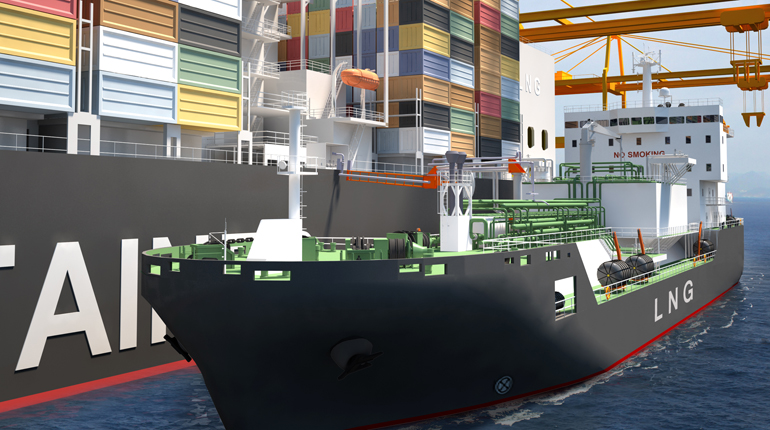Woodside progresses Australia-China bunkering plans
Australia could open up a new market for its LNG as Woodside and its partners in the Green Corridor bunkering project forge ahead with plans for LNG-fuelled vessels Australia could open up a new market for its LNG as Woodside and its partners in the Green Corridor bunkering project forge ahead with plans for LNG-fuelled vessels.
9 June 2017
0
26296
 Green Corridor plans to develop LNG-fuelled vessels for the Australia-China dry bulk trade route. (Shell)
Green Corridor plans to develop LNG-fuelled vessels for the Australia-China dry bulk trade route. (Shell)
Woodside and its partners in the Green Corridor LNG bunkering project are pressing ahead with plans to develop LNG-fuelled vessels for the Australia-China dry bulk trade route. The concept looks like opening up a new growth market for Aussie LNG, providing certain logistical challenges can be overcome.
Last week, Green Corridor’s joint industry project partners BHP Billiton, Fortescue, Mitsui OSK Lines, Rio Tinto, SDARI, U-Ming, Woodside Petroleum and DNV GL unveiled their LNG-fuelled Newcastlemax ship design, which is seeking Approval in Principle from shipping group DNV GL. Green Corridor’s aim is to design, build and commercialise new LNG-fuelled vessels to export iron ore and coal from Australia to the Chinese market.
Woodside would truck LNG for the project from its North West Shelf and Pluto LNG facilities to BHP’s iron ore export points in the north of Western Australia (WA). The group is already working with EVOL LNG to trial LNG bunkering at Dampier Port in WA’s northwest, loading the first carrier in February this year.
When it comes to growth potential, a spokesperson from Woodside told Interfax Natural Gas Daily that "in terms of the size of the market, iron ore ships moving from north WA to Asia currently use 5 billion litres per year of heavy fuel oil".
"Wood Mackenzie has previously estimated that if the entire global shipping fleet converted to LNG, the market could account for more than 200 mtpa of demand, which compares with total global trade of about 250 mt last year," the Woodside spokesperson added.
Emission restrictions
Developing LNG-fuelling infrastructure for vessels on the Australia-China iron ore and coal trade route has been long contemplated by charterers, shipowners and operators. Growing LNG production, especially in Australia, and the upcoming International Maritime Organisation (IMO) restrictions on sulphur emissions, have made the use of LNG as a single-system solution for emissions compliance increasingly attractive.
In its latest Tracking Clean Energy Progress: 2017 report, the International Energy Agency said the global shipping industry is not on track to meet emission limitation targets, putting it under pressure to develop a solution.
This means there is huge potential for a collaborative venture, such as Green Corridor, to grab a dominant share of a new growth market. WA is a particularly attractive area for bunkering as the LNG production infrastructure is already in place and it is near to established iron ore export points. Furthermore, the global oversupply of LNG is expected to support the uptake of LNG across transport markets, including shipping.
The future of bunkering
Analysts acknowledge LNG-fuelled shipping is a growth area, but also that its potential is hard to gauge. Sajal Kishore, director of energy and utilities for Asia Pacific at Fitch Ratings, told Interfax Natural Gas Daily that, although LNG-fuelled shipping "could become another revenue stream [for Aussie LNG] in future, it’s not clear by how much because the industry is still in its infancy".
In particular, specific technical and economic challenges still need to be overcome. "The amount of bunker fuel burnt in the shipping market is huge, so the potential market for LNG here is big but it’s not a slam-dunk," Will Pulsford, upstream and LNG adviser at Poten & Partners, told Interfax Natural Gas Daily.
"The issue is how quickly the shipping fleet will be able to use LNG, and there are a few issues here. Converting vessels from fuel oil to LNG is not easy and the economics are not fantastic. New builds are possible, but how quickly does the fleet turn over to get new builds in to consume the LNG?" Pulsford said.
"Infrastructure is also a problem since there are only a few places in Asia where you can fill up at the moment. So there’s a timing issue in terms of enough ships becoming capable of burning LNG and enough infrastructure [being] built to supply them," Pulsford added, noting that market growth for LNG-fuelled vessels is likely to be incremental rather than dramatic.
LNG is also not the only fuel that shippers can use to meet emission caps, making its uptake in marine haulage still uncertain. According to a spokesperson for the IMO, "LNG is recognised as one way in which ship operators can meet the sulphur limit […] which will come into effect on 1 January 2020. IMO is not promoting any one type of fuel – those decisions are for the ship operators and the markets to make. It is down to ship operators to decide how to meet the requirements".
Liked this article?
To access similar premium content, you or your organisation must have a paid subscription. Sign up for a free 7-day trial to demo this service or call +44 (0)20 3004 6203 and one of our representatives would be happy to walk you through the service.
Sign upTalk to us
Natural Gas Daily welcomes your comments. Email us at [email protected].





